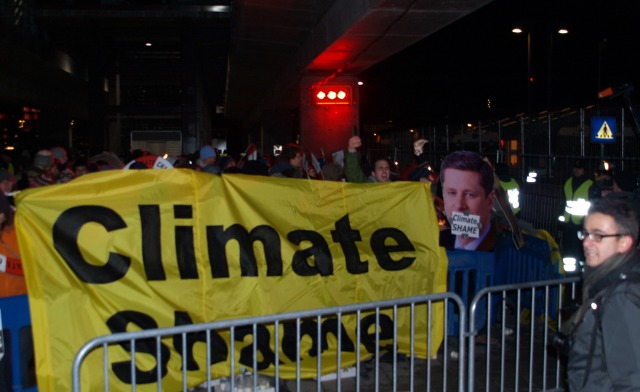Behind talking points - Canadian climate policy update Day 1
Behind talking points - Canadian climate policy update Day 1

At climate negotiations in Durban South Africa, Canada is the talk of the conference, with Canada receiving the first fossil fool award of 2011 for its continued, unfettered destruction of our climate.
Kyoto Protocol
As if Canada could get any worse on climate issues, it now plans to officially withdraw from the Kyoto Protocol, the world’s only international, legally binding agreement to reduce greenhouse gas emissions. This is a breach of trust to other countries for a promise Canada made and has failed to keep and is despite that the majority of the world wants drastic reductions in emissions and a second commitment of Kyoto.
Going back on its word for reducing emissions marks the end of the rope in Canada’s descent from leader on climate change, to its most dangerous obstacle. Canada was once hailed for its initiative on international cooperation. It was actually Canada who proposed Kyoto to reduce international emissions agreeing to reduce carbon emissions 6% below 1990 levels. And now we are completely abandoning the responsibility we once took seriously.
Financing to support adaptation and mitigation in the Global South
In the same announcement, Canada also called attention to the $400 million on climate financing. Why did Canada make feature this today, when it had already agreed to the $400 million months ago?
This is a clever way of disguising Canada’s inaction on climate change. After abandoning its responsibilities to Kyoto, the government tried to cover up its destruction of the climate with the money its spending to supposedly assist in mitigating and adapting to climate change. This is as if you announced you were no longer going to make an effort to stop killing people, but then reassuring others by saying you will finance the purchase of band-aids, stretchers, and other medical supplies.
The $400 million on support for adaptation is no concession for its unfettered destruction of the climate. The Canadian government is spending much more on fueling climate change, than it is on mitigating and adapting. The press is playing off Canada’s announcement to give 400 million$ to adaptation as some huge success, but this is only a small percentage of the money that goes to fueling climate change through subsidies for the oil and gas industry at $1.4 billion per year. If the government was serious about climate change, it would stop funding it, as well as provide its fair share to adaptation for the harm is has already caused.
In addition, the ways the money is being used does not always support the communities it claims to. Canada is giving out 50% of the 400 million in loans instead of grants. These have the effect of further indebting the countries who are the least responsible for climate change.
World Bank Financing & REDD+
Some of the money is even going to supporting polluters instead of people. If this money follows the same path as past climate financing in Canada, the lion’s share of it will go to the World Bank. With its funding for the 2010-2011 year, Canada provided $285.7 million to be used for clean energy projects in developing countries International Finance Corporation (IFC), a member of the World Bank Group, and $40 million to the World Bank’s Forest Carbon Partnership Facility’s (FCPF) to address deforestation and forest degradation in developing countries. Money given to the World Bank raises serious red flags given that many of ‘clean energy projects’ are greenwashing for extractive industry projects, such as the World Bank sponsored coal plant here in South Africa.
Many of the initiatives Canada is supporting are simply ways of evading its own responsibility for stopping destruction. The money going to the FCPF is a financing mechanism for financing REDD projects. Canada is therefore financing REDD+. Why is REDD+ a problem? The project essentially forces communities from the global South and from Indigenous communities to stop using trees freely for living and cultural practices, then gives rich countries like Canada credits to allow the government to continue polluting.
Im sum, based on Kent’s speech, it seems Canada has a two step process for continuing to destroy the climate while minimizing backlash. Step 1. Make official that we don’t have to reduce emissions so that we can’t face sanctions for continuing to destroy the climate. Step 2. Try to reassure people that we are not destroying the climate by referencing a few bucks we’re paying for false solutions for a problem we’ve caused.
So what is the next step for us? By using creative direct action like the innovative one done by the CYCC today, and continue to raise the pressure on the Canadian government to change its ways.
Brought to you by the Canadian Youth Delegation to COP17, this post first appeared on cyd-djc.org

